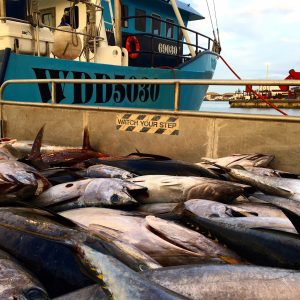Is it economically beneficial for fishermen to listen to scientists? “If you’re getting less than $2.50-3.00 you’re losing money,” says Hawaii Seafood Council Program Manager John Kaneko as he moves us out of the rain and into the Honolulu Fish Auction facility. John is discussing the price point for bigeye tuna for the fishing fleet of approximately 140 boats, which lands 90% of the commercial seafood in Hawaii.
John is a scientist dedicated to supporting the Hawaii seafood and fishing sectors, working to educate consumers who come on his tour of the fish auction. His passion for the Hawaii longline fishery is apparent as he enthusiastically discusses reproductive rates and ideal weights for tuna. He describes the quality of bigeye tuna and the sustainability surrounding the Hawaiian longline industry, going so far as to tell us “if you’re buying imports and buying cheap, you’re part of the problem.” The problem he is referring to is the unsustainable harvest of fish that occurs in countries that do not have standards equal to the Hawaiian longline industry, an industry that has 100% observer coverage. Federally mandated observers accompany fishermen to collect data and ensure compliance with regulations.
A common narrative in fisheries management is that of the distrust between fisheries scientists and commercial fishermen. This narrative can be found throughout the United States, where fishermen may refuse to allow observers on board and openly discuss their doubts about the data collected by fisheries scientists. But with John, the knowledge exchange between fishermen and scientist may prove beneficial for both parties.
He explains how the tuna coming off these vessels can be up to 16 days old. The product is fresh, which means it has only been iced or refrigerated rather than frozen, gilled and gutted onboard. With the typical shelf life of tuna being approximately 21 days, and shelf life for sashimi being a week, these long trips can prove difficult for fishermen getting a high price for their catch.
John mentions how 30% of the fish from this auction heads to the mainland, and 2% is a true export of high grade tuna to places like Japan. When deciding on tuna, you want some fat, and a meat that has good clarity, color and texture. The better the quality, the better the price. As we are led through the rows of fish on the auction floor, we see fish priced from $2 to $11, a significant difference for a 150+ pound fish.
John’s advice to fishermen is to limit their number of sets by one to get their catch to market faster. He states that if your last sets aren’t good, this fresher fish with a higher quality meat will catch a higher price, and you will be allowed one more set at the end of the year. This solution allows fishermen to put in a little less effort and make more money off less fish. John informed us that while some fishermen do take this advice, most do not. An open knowledge exchange between fishermen and scientists has proved beneficial in many other collaborations, and in this case, it can increase profits. Why not listen?

